Church of MO: Y2K 250 Motocross Shootout!
Since whenneth does MO do dirtbike shootouts? Heck, we barely review dirtbikes at all. Not sure who the “Staff” is that wrote this, but whoever it was must have been involved in some kind of ploy to borrow a bunch of new 250s for as long as possible, in the name of science; that the great photographer and Dirt Rider alumnus Mark Kariya shot the photos offers a clue. Those were the days my friend, when you mixed the oil in your gas, had no valves to adjust, and rode like the wind.
Y2K 250 Motocross Shootout
The Main Event!
Here it is, then: Motorcycle Online’s 250 Motocross Shootout. We gathered the Honda CR250, Yamaha YZ250, Kawasaki KX250 and Suzuki RM250 together with five test riders ranging in skill from local pros right down to a 125-class intermediate rider who had never spent any significant time on a 250 before this test. We visited a number of tracks in Southern California and even managed to race a few times; results notwithstanding, everything came up roses.
As one tester put it, “picking a winner is easy, the rest is @*!# hard!”
It’s rare that a multi-bike comparison comes out with a unanimous winner. The rest of the bikes are all so close they could tie for second-place honors, but that wouldn’t be any fun, so we assigned points for each category of handling and motor qualities and, in the end, came up with a place for every bike.
We averaged each evaluator’s score for each bike in each category. All categories were weighted evenly with the winner receiving a bonus point.Thus, the winner in each category received five points, with three points to second place, two for third and one for fourth place.
The overall winner is the bike with the most points. Simple? You bet, so let’s get on with it.
Fit and Finish
Honda came out on top due to what was generally regarded as the best designed bike. The CR looked great and the fit and finish of every piece worked without flaw. There were very few complaints about a protrusion or nuisance anywhere. The engineers spent a lot of time on this bike and it shows.
Yamaha and Suzuki delivered packages that aren’t far behind the Honda, though not quite as polished overall. On the Kawasaki, some riders complained about the side-panels and shrouds that grabbed boots, and that hurt its overall ratings in this category.
Finishing Order:Honda, Yamaha, Suzuki, Kawasaki
Motor
The RidersTim Telford: Height: 6′ 5″ Weight: 185 lbs Ability: Vet ProTrevor Vines: Height: 5′ 10″ Weight: 155 lbs Ability: Pro
Jason Webb: Height: 5’8″ Weight: 160 lbs Ability: Intermediate
Chris Tocco: Height: 5′ 7″ Weight: 150 lbs Ability: Pro
Todd Gosselaar: Height: 5′ 7″ Weight: 142 lbs Ability: Intermediate
The Honda barely edged out the Yamaha in this category. In addition to winning every impromptu drag race, the scorecards regarded the CR’s motor as completely usable throughout the powerband, always able to put its abundant power to the ground. While some testers picked other motors as tops, the CR never finished outside of second-place. From novices to experts, everyone was delighted with the Honda’s motor. The Yamaha offered up a usable powerband as well, receiving good marks for its power, though most evaluators wished for more midrange hit. The Kawasaki had monster motor in the basement but it hit hard and could be tricky to manage in slick situations. It revved through a decent midrange but then signed off abruptly, forcing the rider to shortshift. The Suzuki received one vote for best motor, but everyone except one intermediate
class tester asked for more power. They were never completely
satisfied by the yellow machine’s output.
Finishing Order:Honda, Yamaha, Kawasaki, Suzuki
Transmission
The Yamaha scored high points for a slick-shifting tranny and its adjustable perch. Only the Suzuki drew complaints, and even in the RM’s case it was only to missed shifts and what felt like a clutch that didn’t always operate as smoothly as it could. There were also a few mentions of missed shifts on the Kawasaki,but everything worked well and the shifting was never a significant point of concern. Neither the Honda nor the Yamaha drew anything but praise for their slick shifting. The edge here goes to the Yamaha, though, for it’s adjustable lever and a smooth and easy pull.
Finishing Order:Yamaha, Honda, Kawasaki, Suzuki
Ergos
Again, the Honda was the bike of choice. The CR was roomy and everyone from our smallest five-foot-seven-inch tester to our tallest six-foot-five-inch tester had room to move. Still, nobody thought the bike felt too stretched out or large, either. Ergos that allowed testers to get weight over the front wheel helped the RM rail tight corners. Yamaha also came up with an excellent ergonomic package that was only held back by a few comments from the short riders about the handlebars being too tall. The Suzuki and Kawasaki fell closely behind with the most complaints being centered around the Kawi’s “cluttered” feeling. Most riders felt the pegs were too high and, even with the bar-clamp in the forward-most position, our riders felt too cramped.
Finishing Order:Honda, Yamaha, Suzuki, Kawasaki
Front Suspension
Comments in this category ranged from “the best stock fork I’ve ever ridden on,” to “unstable and harsh.” The evaluators worked hard at trying to set up the forks to match their ability and the changing track conditions. Some bikes responded better than others, and the Honda came out of the crate set up almost perfectly for every rider. Hardly any clicks or fork-height adjustments needed to be made for the CR to put a smile on every face. In second place was the Yamaha which after a couple of tweaks to suit each rider’s preference, worked almost as well as the Honda.
We liked the Kawasaki’s plush overall feel but, when we opened the throttle, the front end had a tendency to ride high and push in the corners. The Suzuki, while not equipped with a bad fork, seemed excessively harsh and prone to bottoming. We couldn’t seem to click this problem away as we did on the Honda and the Yamaha.
Finishing Order:Honda, Yamaha, Kawasaki, Suzuki
Rear Suspension
Again, comments about the Honda were few since most everyone regarded it as very “smooth and consistent,” although our lightest (sub 150-pound) testers made comments about a stiff spring. The Yamaha was once again on the Honda’s heels with two riders preferring it because it felt “a little bit more stable. Very little kicking or deflection.” Still, the blue bike fell short by a few points since it drew a few more criticisms than the Honda for its inability to soak up choppy, pothole-infested straights.
The Honda’s rear shock was never a target for complaints. The Suzuki never felt secure or planted and drew criticism for its desire to dance over braking bumps. The consensus was that it bottomed too frequently and, after we fiddled with compression and rebound adjustments, became even more prone to hopping with only a slight decrease in bottoming-resistance. The same was said of the Kawasaki. No tester ever felt they were able to dial it in to the point where it worked acceptably.
Finishing Order:Honda, Yamaha, Suzuki, Kawasaki
More by John Burns




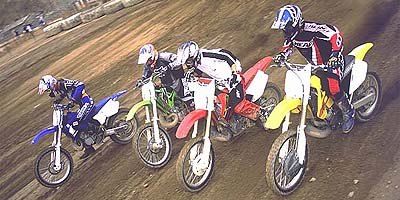













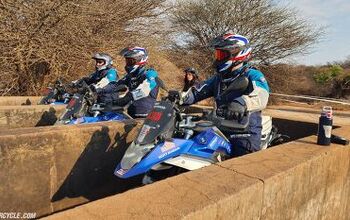

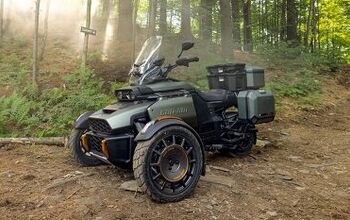

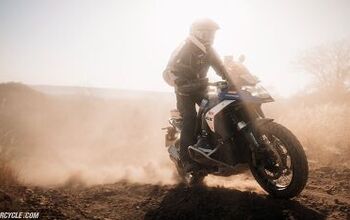
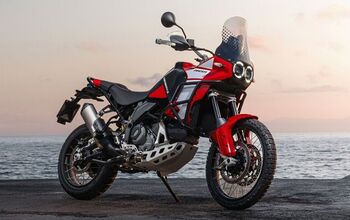



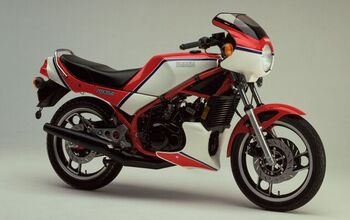

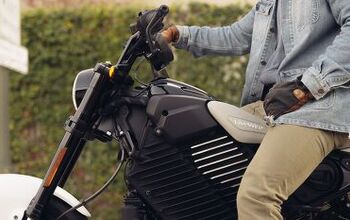



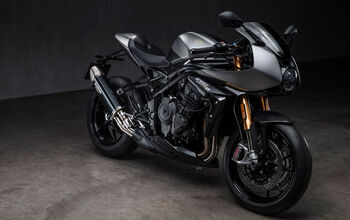


Comments
Join the conversation
My buddy Josh still has a CR250 from that era (2001). As stated in the article, the twin chamber Showa forks on that old CR are really good - better than anything KTM puts out to this day for off road riding as far as I am concerned.
The bike has been amazingly tough and reliable too. He is an "A" level rider and hauls ass on it. The bike probably has a couple thousand hours on it and looks like it has been tossed off a mountain a dozen times. It is not pretty, but it runs great and it is well maintained if rough looking. Josh has a new Husky TX 300 and keeps his old CR as a loaner bike. What a steadfast machine that Honda is.
The beauty of the CR is it is a highly capable bike that is not a cosmetic concern, so a good rider is fully free to do stuff on it that they might shy away from on an expensive and "pretty" dirt bike. While my buddy seems unconcerned, I would be worried about my body and injuring badly in a remote area if attempting something like this, so I didn't. I just shot the video.
Somehow the song choice, odd as it is, seemed appropriate - LMAO...
https://www.youtube.com/wat...